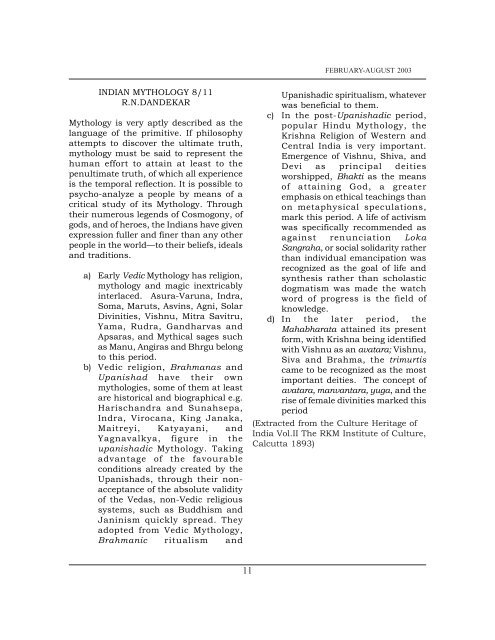Epics in Imprints-1.pdf - Vivekananda Kendra Prakashan
Epics in Imprints-1.pdf - Vivekananda Kendra Prakashan
Epics in Imprints-1.pdf - Vivekananda Kendra Prakashan
You also want an ePaper? Increase the reach of your titles
YUMPU automatically turns print PDFs into web optimized ePapers that Google loves.
INDIAN MYTHOLOGY 8/11<br />
R.N.DANDEKAR<br />
Mythology is very aptly described as the<br />
language of the primitive. If philosophy<br />
attempts to discover the ultimate truth,<br />
mythology must be said to represent the<br />
human effort to atta<strong>in</strong> at least to the<br />
penultimate truth, of which all experience<br />
is the temporal reflection. It is possible to<br />
psycho-analyze a people by means of a<br />
critical study of its Mythology. Through<br />
their numerous legends of Cosmogony, of<br />
gods, and of heroes, the Indians have given<br />
expression fuller and f<strong>in</strong>er than any other<br />
people <strong>in</strong> the world—to their beliefs, ideals<br />
and traditions.<br />
a) Early Vedic Mythology has religion,<br />
mythology and magic <strong>in</strong>extricably<br />
<strong>in</strong>terlaced. Asura-Varuna, Indra,<br />
Soma, Maruts, Asv<strong>in</strong>s, Agni, Solar<br />
Div<strong>in</strong>ities, Vishnu, Mitra Savitru,<br />
Yama, Rudra, Gandharvas and<br />
Apsaras, and Mythical sages such<br />
as Manu, Angiras and Bhrgu belong<br />
to this period.<br />
b) Vedic religion, Brahmanas and<br />
Upanishad have their own<br />
mythologies, some of them at least<br />
are historical and biographical e.g.<br />
Harischandra and Sunahsepa,<br />
Indra, Virocana, K<strong>in</strong>g Janaka,<br />
Maitreyi, Katyayani, and<br />
Yagnavalkya, figure <strong>in</strong> the<br />
upanishadic Mythology. Tak<strong>in</strong>g<br />
advantage of the favourable<br />
conditions already created by the<br />
Upanishads, through their nonacceptance<br />
of the absolute validity<br />
of the Vedas, non-Vedic religious<br />
systems, such as Buddhism and<br />
Jan<strong>in</strong>ism quickly spread. They<br />
adopted from Vedic Mythology,<br />
Brahmanic ritualism and<br />
11<br />
FEBRUARY-AUGUST 2003<br />
Upanishadic spiritualism, whatever<br />
was beneficial to them.<br />
c) In the post-Upanishadic period,<br />
popular H<strong>in</strong>du Mythology, the<br />
Krishna Religion of Western and<br />
Central India is very important.<br />
Emergence of Vishnu, Shiva, and<br />
Devi as pr<strong>in</strong>cipal deities<br />
worshipped, Bhakti as the means<br />
of atta<strong>in</strong><strong>in</strong>g God, a greater<br />
emphasis on ethical teach<strong>in</strong>gs than<br />
on metaphysical speculations,<br />
mark this period. A life of activism<br />
was specifically recommended as<br />
aga<strong>in</strong>st renunciation Loka<br />
Sangraha, or social solidarity rather<br />
than <strong>in</strong>dividual emancipation was<br />
recognized as the goal of life and<br />
synthesis rather than scholastic<br />
dogmatism was made the watch<br />
word of progress is the field of<br />
knowledge.<br />
d) In the later period, the<br />
Mahabharata atta<strong>in</strong>ed its present<br />
form, with Krishna be<strong>in</strong>g identified<br />
with Vishnu as an avatara; Vishnu,<br />
Siva and Brahma, the trimurtis<br />
came to be recognized as the most<br />
important deities. The concept of<br />
avatara, manvantara, yuga, and the<br />
rise of female div<strong>in</strong>ities marked this<br />
period<br />
(Extracted from the Culture Heritage of<br />
India Vol.II The RKM Institute of Culture,<br />
Calcutta 1893)

















